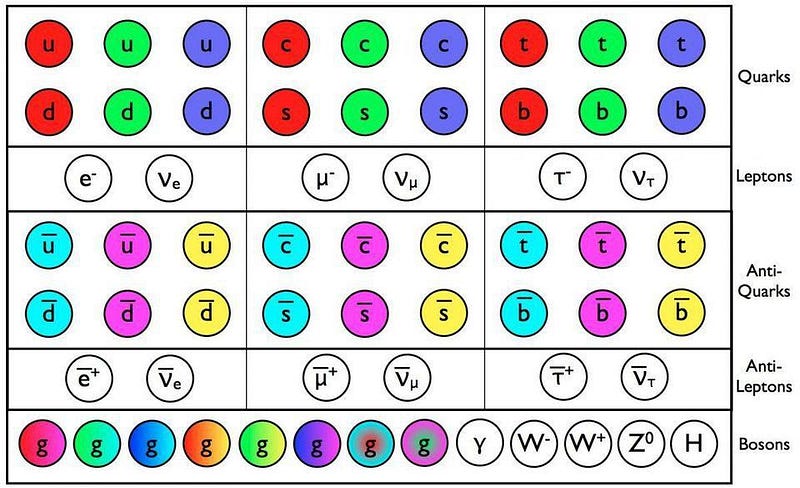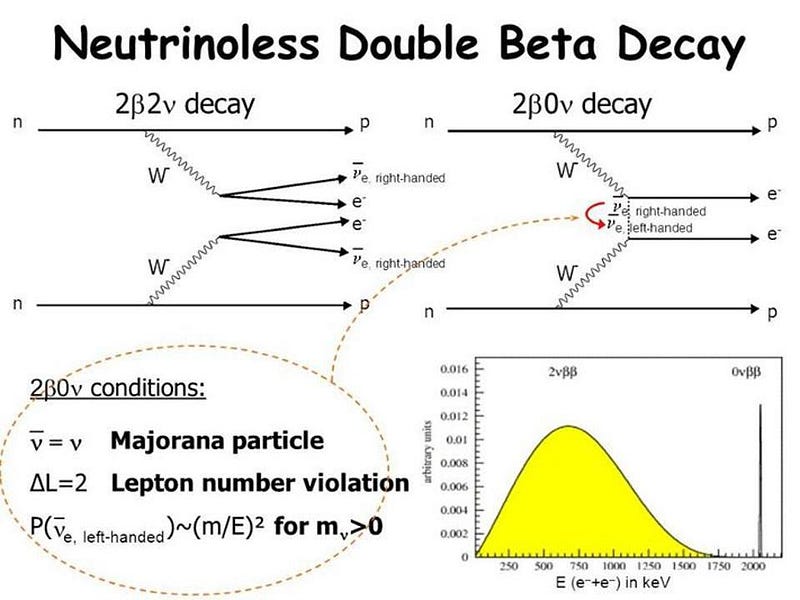How Massive Neutrinos Broke The Standard Model


Neutrinos, which took 26 years to discover from when they were first proposed, are the only known particles to thus far break the Standard Model.
It wasn’t supposed to be this way. Neutrinos, these tiny, ghostly, elusive but fundamental particles, weren’t supposed to have mass. According to the Standard Model of elementary particles, we should have three types of neutrino (electron, muon and tau) and three types of antineutrino, and they should be stable and unchanging in their properties once they’re created.
Unfortunately, the Universe had other ideas in store for us. Ever since the 1960s, when the first calculations and measurements for neutrinos produced by the Sun came in, we realized there was a problem: because of how the Sun shines, we knew how many (electron) neutrinos were produced in its core. But when we measured how many (electron) neutrinos were arriving, we only saw a third of the predicted number. The story of unlocking this mystery remains the only robust way that particle physics has gone beyond the Standard Model, and may yet hold the key to further understanding the Universe. Here’s how.

The neutrino got its start some 90 years ago, when physicists were puzzling out one of the more frustrating observations of physics: the problem of beta decay. There are a number of atomic nuclei — tritium, for example — that are unstable against radioactive decays. One of the most common ways for an atomic nucleus to decay, particularly if it has an unusually large number of neutrons in it, is through beta decay: where a neutron in the nucleus decays into a proton by emitting an electron.
For many years, we detected the proton that’s left behind as well as the emitted electron, but something was missing. There are two quantities that are always conserved in particle physics:
- energy, as the total energy of the reactants always equals the total energy of the products,
- and momentum, as the total momentum of all the initial particles always equals the total momentum of the final particles.
But somehow, for these beta decays, something was always missing: both energy and momentum were not conserved.

Some, like Niels Bohr, had the radical suggestion that maybe energy and momentum weren’t really conserved; maybe they could somehow be lost. But Wolfgang Pauli had a different — arguably, even more radical — thought: that perhaps there was a novel type of particle being emitted in these decays, one that we simply didn’t yet have the capacity to see. He named it “neutrino,” which is Italian for “little neutral one,” and upon hypothesizing it, remarked upon the heresy he had committed:
I have done a terrible thing, I have postulated a particle that cannot be detected.
According to Pauli’s theory, there was a new class of particle that was emitted in certain nuclear reactions. When a neutron decays to a proton and an electron, it must also create an anti-electron neutrino, conserving both lepton number (the total number of leptons minus the total number of anti-leptons) and lepton family number (the same number of leptons minus anti-leptons in each of the electron, muon, and tau families). When a muon decays to an electron, it must produce a muon neutrino and an anti-electron neutrino to conserve everything that’s required.
Proposed in 1930, Pauli’s wild theory was vindicated in 1956, when the first (anti)neutrino was detected from their production in nuclear reactors.

Once we began to understand how nuclear reactions powered the Sun, however, it became clear that the largest source of neutrinos on Earth wouldn’t be from the nuclear reactions that humans created, but from the Sun itself. Inside the Sun, some ~10³⁸ nuclear reactions happen every second, producing electron neutrinos (along with positrons) each time a proton gets transmuted into a neutron in the eventual formation of heavier elements like helium. Based on how much energy the Sun outputs, we can calculate the number density of these electron neutrinos that must be continuously arriving on Earth.
We figured out how to build neutrino detectors, creating enormous tanks full of material for them to interact with, surrounding them with detectors that were extremely sensitive to even a single interaction of a neutrino with a target particle. But when we went to measure these neutrinos in the 1960s, we got a rude awakening: the number of neutrinos arriving was only about a third of what we were expecting. Either something was wrong with our detectors, something was wrong with our model of the Sun, or something was wrong with the neutrinos themselves.

Reactor experiments quickly disproved the notion that something was amiss with our detectors; they worked exactly as expected, with efficiencies that were extremely well-quantified. The neutrinos we were detecting were being detected in proportion to the number of neutrinos that were arriving. For decades, many astronomers argued that our model of the Sun must be flawed, but the models that most strongly agreed with all of the electromagnetic data predicted a much larger neutrino flux than what we observed.
Of course, there was another wild possibility that — if correct — would alter our picture of the Universe from what the Standard Model predicted. The wild possibility is this: that the three types of neutrinos that we have are actually massive, rather than massless, and that they can mix together, just like the different types of quarks (with the same quantum numbers) can mix together.
And, putting it all together, if you have a large amount of energy in these neutrinos, and these neutrinos pass through matter (like the outer layers of the Sun or the Earth itself), they can actually oscillate, or change type from one flavor into another.

This picture was validated in the 1990s and 2000s, as we began to perform experiments that were sensitive not only to electron neutrinos, but to the muon and tau neutrinos that they could oscillate into. It received further validation when we performed these measurements on not only solar neutrinos, but atmospheric neutrinos generated by high-energy cosmic ray impacts. When all the data was combined, a single picture emerged: neutrinos do have non-zero mass, but the masses are extremely tiny; it would take more than 4 million of the heaviest flavor of neutrino to add up to the next-lightest Standard Model particle: the electron.
If neutrinos have mass, some properties that they have fundamentally change. For example, every neutrino we’ve ever observed is intrinsically left-handed: if you point your left thumb in the direction that it’s moving, its spin (or angular momentum) is always oriented in the direction that your left hand’s fingers curl around your thumb. Similarly, anti-neutrinos are always right-handed: point your right thumb in their direction of motion, and their spin follows your right hand’s fingers.

Now, here’s the thing. If neutrinos are massless, they’d always move at the speed of light, and you’d never be able to move faster than one. But if they’re massive, they move at speeds lower than the speed of light, which means that it’s possible to boost your speed to move faster than a neutrino while still moving slower than light.
Imagine, then, that you’re coming up behind a neutrino, watching it move ahead of you and seeing it spin in a left-handed, counterclockwise direction from your perspective. Now, you speed up, and you pass the neutrino, and so you look back at it from ahead of it.
What do you see?
You see that it’s now moving away from you, and it appears to spin clockwise, rather than counterclockwise. Just by changing your relative motion with respect to the neutrino, you’ve seemingly transformed it from a neutrino into an antineutrino. Why? Point your thumbs away from you and see: only if you use your right hand do you get a clockwise rotation from something pointed away from you.

Is this possible? Could a particle like a neutrino actually be its own antiparticle?
Not according to the plain old Standard Model. Not if neutrinos are massless. But if you go beyond the Standard Model and allow neutrinos to have mass — which you have to do to be consistent with what we observed — it’s not only allowed, it’s arguable that it might be the best explanation possible.
Fermions, in general, aren’t supposed to be their own antiparticles under the normal Standard Model. A fermion is any particle with a spin of ±½ (or half-integer spin, in units of Planck’s constant), and includes all the quarks and leptons, i.e., including the neutrinos. But there’s a special type of fermion that only exists in theory so far: a Majorana fermion, which is its own antiparticle. If true, there would be a very special reaction that could take place: neutrinoless double beta decay.

Scientists are presently running experiments searching for this rare type of decay, which requires neutrinos to be their own antiparticle. In single beta decay, a neutron converts into a proton, an electron, and an anti-electron neutrino. You can also have — although it’s very rare — double beta decay, where two neutrons convert into two protons, two electrons, and two anti-electron neutrinos. In the case of normal double beta decay, you can tell that the neutrinos are getting created because of the “missing energy” and “missing momentum” that must be carried away.
But, at least in theory, there’s a neutrinoless form of this, where the anti-electron neutrino emitted by one neutron gets absorbed by another neutron that sees it as a regular electron neutrino: its own antiparticle. In that second reaction, the neutron and electron neutrino interact and emit a proton and an electron. Instead of two neutrinos, it would produce zero, but still be a double beta decay.

Neutrinos, unambiguously, cannot be the massless particles that they were originally hypothesized to be. They clearly oscillate from one flavor into another, which is only possible if they have mass. Based on our current best constraints, we now know that a small but non-zero fraction of the dark matter must be made of neutrinos: about 0.5% to 1.5%. That’s the same amount of mass, roughly, as all the stars in the Universe combined.
And yet, we still don’t know if they’re their own antiparticle. We don’t know if they get their mass from a very weak coupling to the Higgs, or whether they achieve it through a different mechanism. And we don’t know, truly, if the neutrino sector isn’t even more complex than we think, with sterile or heavy neutrinos remaining as a viable possibility. While our colliders strive to take us to ever-higher energies, the only bona fide crack in the Standard Model comes from the lightest massive particles of all: the ghostly, elusive neutrino.
Ethan Siegel is the author of Beyond the Galaxy and Treknology. You can pre-order his third book, currently in development: the Encyclopaedia Cosmologica.





